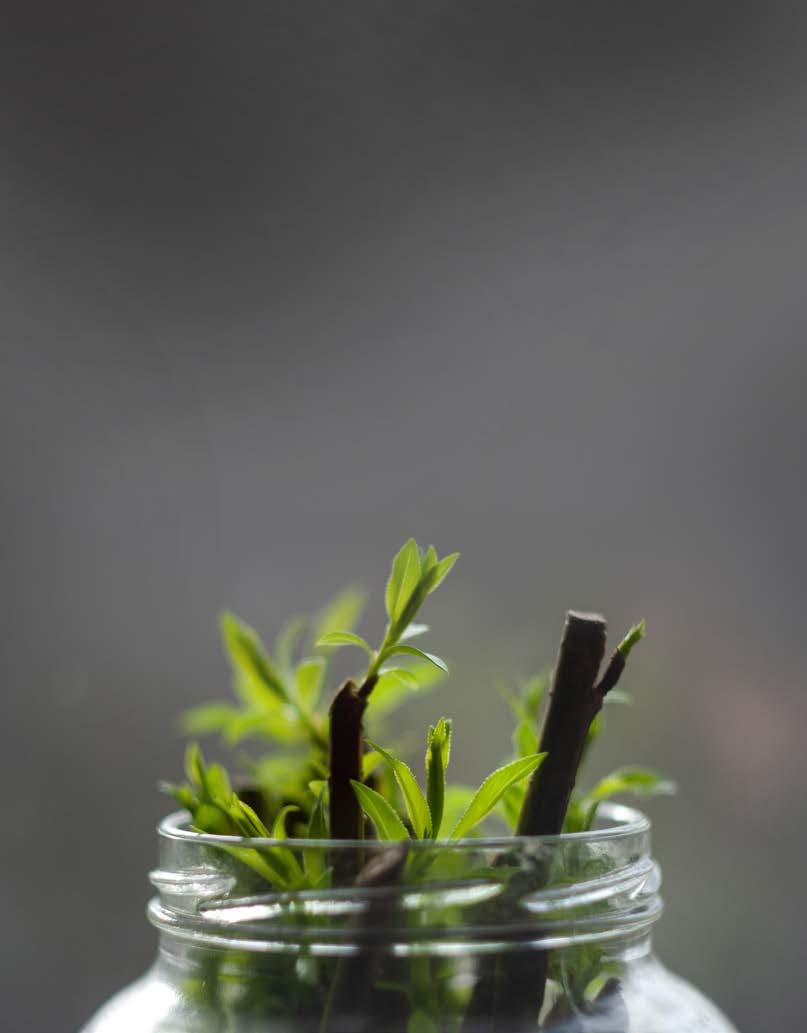
4 minute read
The Ins and Outs of Organic Cloning
BY CODY J GARRETT - TAIT
There comes a time in every organic gardener’s life when they find the remarkable plant that they want to save for future use, whether for breeding or enjoyment. The good news is one doesn’t need to resort to using hormone gels or other synthetically-derived ingredients to clone their prized plants. It is possible to achieve reliable replication organically!
For the best results, it’s essential to understand what is needed for the cloning process. A typical setup usually involves:
A cloning medium such as Rockwool, peat pellets, rooting sponges, perlite and vermiculite blends. Coco and seed raising/propagation mixes are also required.
A cloning tray with a cover and a heat mat.
A propagation gel that contains either the synthetically-derived auxins INAA (1-Naphthaleneacetic acid), IBA (Indole-3-butyric acid), or a combination of both to help with root proliferation and initial callus development.
Foliar cloning nutrients and other adjuncts are also sometimes used to speed up the cloning process.
Cuttings of the desired size are cleanly cut and dipped in the propagation gel. After, they’re placed into the medium and the clone incubator so their roots can develop. This approach is time-proven and effective. However, for soil grows, where the goal is to maximize beneficial microbial activity as early as possible, this approach doesn’t cover all the bases and involves the use of synthetically-derived ingredients.
With a few tweaks, we can easily optimize this process for organics while keeping strike rates high. Without chemical stimulation, we need to attack the problem from various angles.
To help keep the vegetative material healthy while roots develop, foliar applications of diluted amino acids and kelp/ seaweed provide readily available nutrients.
For root growth promotion and callus initiation, several natural methods are at our disposal. The first is the use of silicate compounds, which are useful in aiding natural root proliferation. If you’re searching for a source, you won’t need to look very far. Named after the Salix (willow) tree, which is high in salicin, these natural substances are found in many plant species. Of note is aloe vera, which contains adequate amounts of salicylic acid, a potent plant health promoter.
Horticultural aloe-based products will work very well for organic cloning, both in the initial soak phase and as foliar sprays during the callusing and root development phases. In the old days, willow water was commonly used in nurseries. This is easily made by steeping freshly cut lengths of a willow tree in water to extract the natural compounds. But today, most grow stores will have multiple well-formulated salicylate-containing products for purchase.

Organic soil growers have an advantage
Naturally-derived auxins can also be added for better results. Sprouted seed teas made from corn or legumes such as alfalfa, lentils, and peas are useful, and so is coconut water. These all contain a range of enzymes, biostimulants, and are potent root stimulators. When combined with a seaweed solution or humic and fulvic acid, the combined synergistic effects are quite powerful. By utilizing a combination of the above ingredients as a soak for clones, you can provide the perfect environment for healthy plants.
Growers can also add living microbes to the equation, which will provide further enhancements such as pathogen and disease prevention by crowding out the spots where they would take hold. Microbes such as azospirillum, Trichoderma, bacillus, and mycorrhizal fungal types can influence early root development. They will also allow for rhizosphere colonization at the initial step of the growing process.
Organic soil growers have an advantage. It’s quite common to apply a microbial inoculant at planting time. However, there is a bit of lag between the spores germinating and colonizing the root system. By getting the microbes in early, you are essentially priming the plants and avoiding the lag, corn or legumes with further applications building on this foundation.
The best way to are useful, and so apply is to pre-soak is the media of choice in a combined mixture of the above ingredients and a small amount of the chosen microbial inoculant. After pre-soaking the clones, roll or dip the freshly cut end into the microbe product, just like you would cloning gel before putting it into place.
An effective organic cloning method would be the following:
A cloning medium; this can be any of the above choices.
A cloning tray with a cover and heat mat can be used as with regular cloning.
Instead of propagation gel, we can apply silicate compounds, beneficial microbes (fungi and rhizobacteria), as well as seaweed, humic/fulvic acids, and coconut extracts to fill the void for auxins and root-promoting compounds.
Foliar sprays of amino acid-based products, aloe, and kelp/ seaweed extracts, to preserve carbohydrate reserves.
Pre-soak the chosen media with a mixture of seaweed, humic/fulvic acid, a silicate source (either aloe or willow water), coconut water, or some sprouted seed tea for auxins. To further enhance, add some microbial inoculants.
In a separate container, save some of this mixture and as you cut your clones, allow them to marinate for a few minutes.
Carefully remove and dip the ends in microbial powder and insert them into the media.
Lightly mist with seaweed and amino acids.
If your environment is right, you should have very healthy, strong clones within about a week.
Happy cloning!










